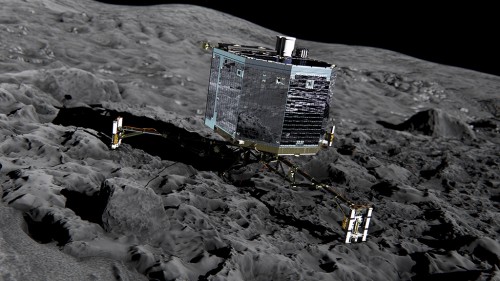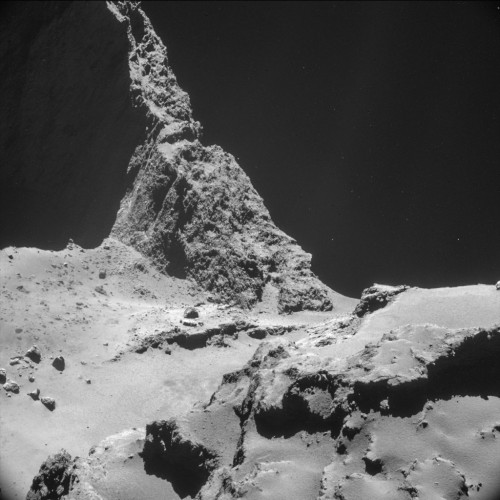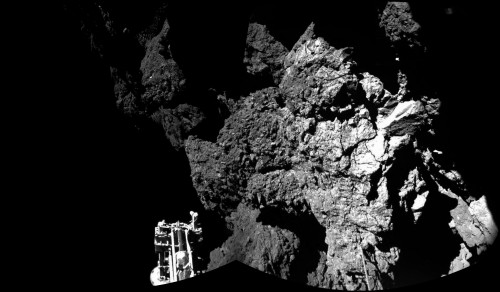Tag archives: ESA
Cassini’s emotional countdown, Steve the light show, shooting hoops ‘granny style’
By Sarah Tesh
This week has seen the beginning of Cassini’s Grand Finale. The rather dramatically named final mission for the NASA spacecraft involves 22 dives between Saturn and its surrounding rings. Once complete, Cassini will crash into the planet’s atmosphere in what the scientists hope will be a flurry of data gathering. The spacecraft has already sent back stunning images of storms in Saturn’s atmosphere from its first dive on 26 April. After 20 years since its launch, the mission to Saturn’s system has been a masterclass in space exploration, and NASA highlights the best bits in this theatrical video. The short film, reminiscent of Star Trek, could be considered a bit cheesy, but it’s hard not to form an emotional attachment to NASA’s loyal Cassini as you join in the countdown to its final demise.
View all posts by this author | View this author's profile
Plush toys launched into space, interplanetary mining missions and more
By Tushna Commissariat
The European Space Agency’s (ESA) Rosetta spacecraft has, as of this week, spent two full years in orbit around comet 67P/Churyumov–Gerasimenko, since it reached its destination in August 2014. While Rosetta was the mothership, it also deposited its “baby” lander called Philae onto the comet’s surface in November that year. Sadly Philae was switched off in July this year. If you feel like you want to relive the excitement of the initial launch, take a look at the video above. The folks over at Design and Data, who created Rosetta’s iconic cartoons and memorabilia for ESA, launched a plush-toy version of the spacecraft into space, to see how it would fare. Watch the video to see how their “mission” played out.
View all posts by this author | View this author's profile
Philae comet lander set for reboot

Here comes the Sun: the Philae lander may reawaken soon. (Courtesy: ESA/ATG medialab)
By Michael Banks
Scientists at the European Space Agency (ESA) are hoping that the Philae lander, which successfully landed on a comet last year, will re-establish contact soon as it travels closer to the Sun. Philae was part of ESA’s Rosetta mission that was launched in 2004 but when Philae separated from Rosetta in November, it landed on the comet in an awkward position. This meant that the craft’s solar panels did not receive enough sunlight to recharge its battery, but the lander’s 10 instruments were able to carry out measurements before it went into hibernation mode about 50 hours after landing.
View all posts by this author | View this author's profile
Last chapter in Rosetta’s Philae lander story…for now

Strange new world: Image of comet 67P taken by Rosetta’s NAVCAM from 10km away.
(Courtesy: ESA/Rosetta/NAVCAM, CC BY-SA 3.0 IGO)
By Tushna Commissariat
Last week was exciting and exhausting for anyone involved in space exploration and astronomy, after scientists working on the Rosetta mission of the European Space Agency (ESA) made history when their “Philae” module touched down safely on the surface of comet 67P/Churyumov–Gerasimenko. But soon after celebrating Philae’s successful landing, a dramatic story unfolded. With a bumpy triple landing, harpoons that did not fire and tether the probe, as well as a final resting spot that lay in the shadows, which meant its solar panels received very little sunlight, Philae’s tumultuous story captivated the interest of thousands of people across the globe.
In the early hours of Saturday morning, as Philae’s batteries slowly drained of power, thousands mourned. “So much hard work..getting tired…my battery voltage is approaching the limit soon now,” Tweeted the Philae crew, and yet, the lander’s story was ultimately happy and successful. Although it spent only 57 “active” hours on the comet, ESA mission scientists were happy to report that the lander had indeed completed the entirety of its primary science mission.
View all posts by this author | View this author's profile
Rosetta’s Philae starts drilling into comet surface

View of a lifetime: Philae safely on the surface of Comet 67P.
(Courtesy: ESA/Rosetta/Philae/CIVA)
By Tushna Commissariat
It had clearly been a long and busy 24 hours for members of the Rosetta mission at the European Space Agency (ESA) as they gave the latest updates in today’s Google+ Hangout. On Wednesday the mission made history as its “Philae” module touched down safely on the surface of Comet 67P/Churyumov–Gerasimenko. But there has been a great deal of drama and uncertainty since then, as it emerged yesterday that the lander’s final resting spot was more than 1 km away from where it was meant to arrive. Also, Philae is thought to be precariously positioned in the shadows on the far side of a large crater, where its solar panels cannot get enough light to operate as planned. Despite these hurdles, the lander’s many instruments have been functioning well and sending data back to Earth, via the Rosetta orbiter.
View all posts by this author | View this author's profile
Herschel in a minute
By Michael Banks
Here is an example of how to condense four years’ worth of space observations into just a minute.
The animation above, which was created by Pedro Gómez-Alvarez of the European Space Agency (ESA), shows a timeline of more than 37,000 scientific observations made by ESA’s Herschel Space Observatory.
The video runs from Herschel’s launch on 14 May 2009 until the infrared observatory made its last observation on 29 April 2013 as the craft’s detectors ran out of coolant.
Herschel – a far-infrared and submillimetre telescope – had two main goals: to study star formation in our galaxy; and galaxy formation across the universe.
Named after the German-born astronomer who in 1781 discovered Uranus, the probe carried a 3.5 m-diameter mirror – the largest to be deployed in space – and investigated light with wavelengths of 55–670 µm.
The craft was placed in an area of space some 1.5 million kilometres further out from the Sun beyond the Earth. Known as Lagrange point L2, it is where a space probe can usefully hover, little disturbed by stray signals from home and without having to use much fuel to keep it in position.
You can find some of the incredible images taken by Herschel at ESA’s multimedia gallery.
View all posts by this author | View this author's profile
Physics World 2013 Focus on Big Science is out now
By Michael Banks

Physics World Focus on Big Science.
All eyes will be on Stockholm next week as the 2013 Nobel Prize for Physics is announced. One of the frontrunners for the prize in the minds of the Royal Swedish Academy of Sciences will surely be the discovery last year of the Higgs boson at CERN’s Large Hadron Collider (LHC).
But the LHC story is far from over and in the latest Physics World focus issue on “big science” find out how the LHC will hunt for new particles beyond the Higgs boson once the collider restarts in 2015 following an 18-month repair and upgrade programme at the Geneva-based lab.
All full members of the Institute of Physics will receive a print edition of the focus issue along with their copy of the October issue of Physics World, but everyone can access a free digital edition. The focus issue also looks at how particle physicists are already thinking about what could come after the LHC, with bold plans for a 80–100 km proton–proton collider. There are even plans for a collider based on lasers, with an international team looking at creating an array of “fibre lasers” to be used as a future “Higgs factory”.
You spin me right round
By Tushna Commissariat
It’s not often that we come across a mention of an astronomical event measured in Earth years, let alone months or hours. So suffice to say I was pretty surprised by a recent XMM-Newton finding that talked about a star orbiting a black hole at the furious rate of once every 2.4 hours! Further investigation revealed that this has only broken the previous record by an hour, but these extremely short orbits still have me rather amazed. Certain short orbital period binary stars or pulsars do have even shorter periods of less than an hour, but this star orbits a stellar-mass black hole (it’s about three times more massive than the Sun) that is roughly a million kilometres away from it. The video below, courtesy of the European Space Agency (ESA), is an animation showing one complete orbit of the star.
View all posts by this author | View this author's profile